Second episode from the work in progress show of the Design Interactions department (Royal College of Art, London).
With BACK, HERE BELOW, FORMIDABLE [ the rebirth of prehistoric creatures ], Marguerite Humeau, attempts to ressuscitate the sound of extinct animals by reconstructing their voicebox (lungs, trachea, larynx + vocal folds, mouth and nose). Made of soft tissue, the vocal tract does not fossilize. The only elements which have been preserved through time are their bones. By comparing them with the larynx CT scans of their closest modern relatives, Humeau hopes to be able to deduce what the vocal organs of the extinct animals looked and sounded like. With the help of a specialist of each animal, the designer plans to remodel the soft tissues of the modern animals on the basis of the bone structure of the extinct one. The structure of the soft tissues will then be printed in 3D.
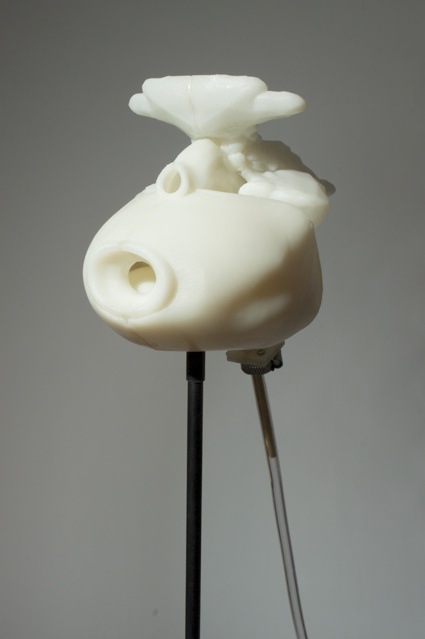 Image courtesy Marguerite Humeau. Lighting by Diego Trujillo
Image courtesy Marguerite Humeau. Lighting by Diego Trujillo
Hi Marguerite! “Back, Here, Below, Formidable” That’s quite a title for a project. What’s behind this long and cryptic (at least to me) title?
Marguerite Humeau: The idea of resuscitating the sound of extinct animals by reconstructing their vocal tract is quite straightforward- but could be seen as problematic on the scientific point of view: because made of soft tissue, the vocal tract does not fossilise. The only things which have been preserved through time are their bones. The idea is to compare them with the vocal tract CT scans of their closest modern relatives. Then we can predict how their vocal organs used to be like.
What was originally a simple idea has now become a quest, a contemporary epic tale. I see this quest as being very romantic and also fetishistic in a sense.
I want to bring back creatures which have existed millions and millions years ago, far before humanity was born. There is something almost mystical in this idea.
In general I am very interested in the fictional potential of scientific experiments and in the role of science in the creation of contemporary mysteries. We seem to live in a ongoing fiction: speculations and stories about what happens in the labs are as powerful as the Real itself. What we know about this Real in only through medias: they are the storytellers. It is really opaque. That’s why we start to invent stories about these experiments: “science- fictions”.
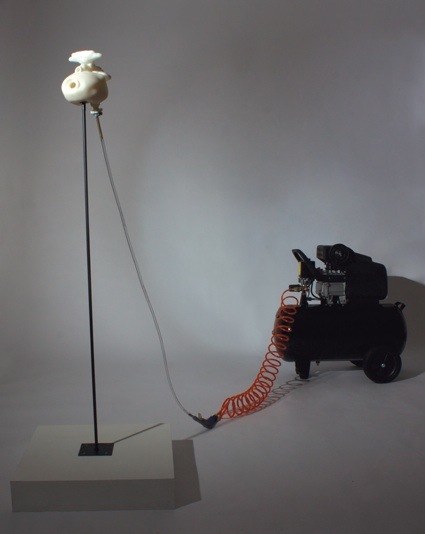 Image courtesy Marguerite Humeau. Lighting by Diego Trujillo
Image courtesy Marguerite Humeau. Lighting by Diego Trujillo
The object i saw in the exhibition space is quite impressive and curious. Could you describe it for us?
Marguerite Humeau: This prototype is the first of a larger series of reborn extinct creatures. Lucy (Australopithecus Afarensis) used to live 3,85 to 2,95 million years ago. It was one of our human ancestors- actually one of the first hominids- the mother of humanity. The remains of Lucy were found in 1974 in Ethiopia. Lucy In the Sky was playing on the radio when they found it, that’s how she is called Lucy.
For this prototype I used the data from a vocal tract ( trachea, larynx- including the vocal chords, mouth, nose, pharynx, and sinuses) CT-scan from a human, and compared it with the data of a chimpanzee and the skull of Lucy.
Lucy’s vocal tract is, scientists believe, actually really close from the one of a chimpanzee. The part of guesswork is then quite easy.
The same process for other animals is not always as simple as it sounds, as some extinct animals do not have any modern relatives, or, happened to evolve and become two or more different genus. For example, the sabre-toothed cat belongs to an extinct genus. From the same family, I could then use a wild cat like a tiger, or, a domestic cat. They come from the same family “felidae”. But these two genus have two very different vocalisation systems- therefore it is hard to predict how the sabre-toothed use to sound like. Maybe it was not even roaring. This is when the prediction part becomes interesting!
Once the vocal tract is reconstructed, I just had to connect it to its artificial lungs ( the air compressor). This part of artificiality gives a curious and, maybe scary impression.
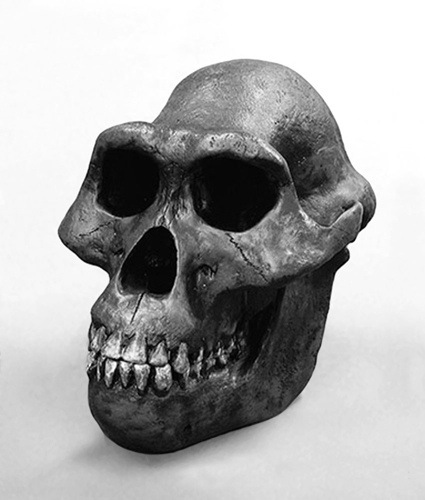 Image courtesy Marguerite Humeau
Image courtesy Marguerite Humeau
How did you get interested in the sound of extinct animals? Did you get some scientific help during your research and design process?
Marguerite Humeau: It all started with a synthetic biology workshop that we did last year, with James King and Daisy Ginsberg. At that time I discovered the work of Hideyuki Sawada who is constructing a “talking robot”- his research is the first time in the history of human voice simulation that the sound is actually made by reconstructing the vocal production system itself- so the voice sounds more natural. I connected this research with a talk from Anthony Atala on TED, about growing organs by 3d printing cells straight from the printer.
It meant to me that not only we are able to reconstruct organisms but we can enhance them. We could print living vocal tracts, and scale them, modifying the vocal cords, to create extra-ordinary voices- which would still sound “human” because coming from an actual larynx.
There was also this episode from Inside Nature’s Giants on Channel 4 in which a team of veterinaries throw air from an air compressor inside a dead lion’s throat- the lion starts to roar again!
I was fascinated by that and I wanted to add an imaginary dimension to it. Because we have never known these extinct animals we project a lot on them- how they use to be like, to sound like etc. They have become icons.
I then started to contact many different people. At first, I met Professor Hideyuki Sawada (who is working on the talking robot) in Japan, and then, palaeontologists, veterinaries, radiologists, engineers, etc. My goal is to get in touch with the world experts of each animal so the research is well grounded. Prof. Joy Reidenberg (also part of Inside Nature’s Giants) was really helpful, she is specialised in animal’s larynges. Alexandra Freeman, researcher on Walking with Beasts program on BBC helped me a lot as well in the beginning. I also got in touch with Dr. David Weishampel, specialised in the vocalisation of dinosaurs- he was Steven Spielberg’s adviser for Jurassic Park. I also had great discussions with Prof. Adrian Lister from the Natural History Museum in London, who is a mammoth specialist.
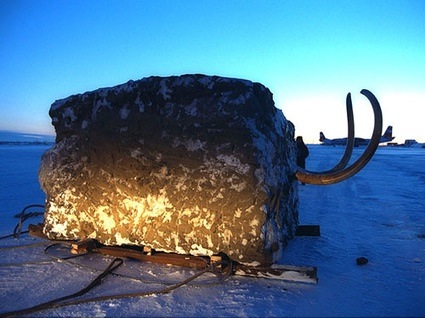 (image source)
(image source)
Another great meeting was with Bernard Buigues, French Explorer, who discovered three frozen mammoths in Siberia. It was fascinating to hear him talking about this beasts. Some of them have been completely preserved in the permafrost, with their organs, and even their fur. They even still have the “smell” of wild animals. Can you imagine what it must be to be able to see and touch these animals, which died thousand of years ago?
And then this week I went to visit the Institute of Wildlife Research in Berlin– they have the scans of many animals vocal tracts and have very good knowledge especially of elephant vocalisation- it was great to meet them as well.
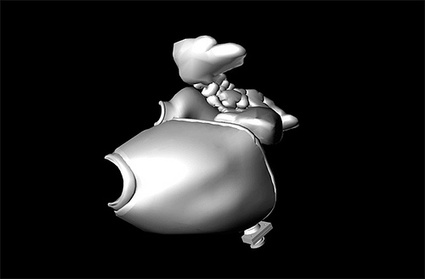 Image courtesy Marguerite Humeau. 3D model made by Clifford Sage
Image courtesy Marguerite Humeau. 3D model made by Clifford Sage
How far are you in the process of resuscitating the sound of these extinct animals? What have you achieved so far and how much is there still left to do?
Marguerite Humeau: To recreate the sound, I need three things: the lungs ( which are the air compressor), the resonance cavities (mouth, nose, etc.), and the vocal folds which sit inside the larynx. Now I found almost all the data for the resonance cavities reconstruction that I need.
What I am working on now is the vocal cords. In reality they are composed of five different layers of tissue of different softness. I am working on creating variations and getting a replica the closest as possible from reality (in terms of frequency, elasticity, tension etc).
Do you plan to work with non-extinct animals? Such as imaginary animals (unicorns or creatures from World of Warcraft for example)?
Marguerite Humeau: I find it really interesting to work on animals which have actually existed. Bringing the dead back to life is fascinating and scary. It also creates a mix of time periods. I like how this project lives on an edge. I think this ambiguity comes from the fact that the project is grounded is very precise scientific data.
As a starting point I have decided to work exclusively on prehistoric mammals because they use their larynx for the production of sound. Birds for example ( as the dodo) use a syrinx which is a completely different system. Dinosaurs used to have a very complex web of air sacs for their vocal production.
There is a “scale of exactitude” of course. For the long-extinct animals we usually have very few fossils, the guesswork is therefore more important. We have a lot of information on the mammoth because it has only been extinct for 5 000 years, especially because of we have found some frozen carcasses as well.
I want to play on this edge of exactitude and prediction, but I think it is really important that there is always a part of real data, if I want people to connect and speculate on the specimens.
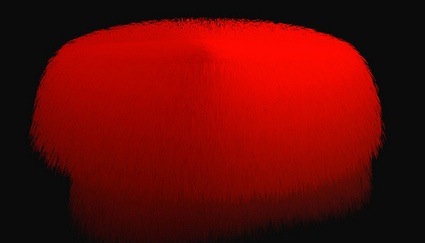 Image courtesy Marguerite Humeau
Image courtesy Marguerite Humeau
And then there the furry red thing you showed me the other day at the show. Can you explain us what it is about?
Marguerite Humeau: It is going to be part of the collection- I would like to involve more abstract pieces in my bestiary, next to the Vocal tract series.
This piece is a synthetic woolly mammoth. I see it made of synthetic bright red hair, almost alive, slightly moving.
There are so many stories about the cloning of the mammoth, like two weeks ago, the team of Japanese researchers who said they could make it happen soon. There are very big hopes that this could happen one day- this speculation is what I am interested in. Do we really want this to happen? What would it mean for us? Will we have to actually make it happen to realise the impact of our cloning technologies?
The reality of what is actually possible to do or not is unclear, we- as the public- don’t really know. Every three month there is a new headline about cloning the woolly mammoth. All this is really abstract to us and we can speculate about it. This is what I want to play with in my next series.
Merci Marguerite!
Also at the show: Known Unknowns.
